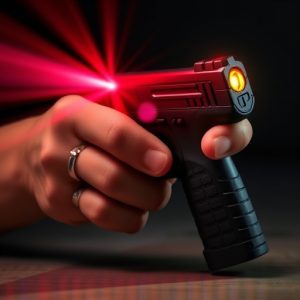Stun Guns: Understanding Electrical Discharge for Effective Personal Defense
Stun guns temporarily disable attackers with high-voltage, low-amperage electric pulses that disrupt…….
Stun guns temporarily disable attackers with high-voltage, low-amperage electric pulses that disrupt nerve pathways controlling muscle function, providing users time to escape or seek help. Their legality varies globally, with many regions permitting them for self-defense in specific settings under strict regulations. When choosing a stun gun, consider voltage output, contact points, battery life, and safety features. Responsible use requires training on handling, activation, distance, and local laws to minimize risks of injury.
Personal defense weapons, particularly stun guns, have gained popularity as tools for self-protection. This article explores the concept of electrical discharge for personal safety, delving into the science behind stun guns and their effectiveness in disorienting and immobilizing attackers. We’ll guide you through understanding how these devices work, navigating legal considerations, choosing the right stun gun, and implementing safety precautions to ensure responsible use. By the end, readers will have a comprehensive grasp of both the capabilities and limitations of stun guns.
- Understanding Electrical Discharge for Personal Defense: A Stun Gun Overview
- The Science Behind Stun Guns: How They Disorient and Immobilize
- Legal Considerations: Where and When Can You Legally Use a Stun Gun?
- Choosing the Right Stun Gun: Factors to Consider for Optimal Performance
- Safety Precautions and Training: Ensuring Responsible Use of Personal Defense Weapons
Understanding Electrical Discharge for Personal Defense: A Stun Gun Overview
Electrical discharge weapons, commonly known as stun guns, offer a non-lethal personal defense option by delivering a powerful electric current that temporarily incapacitates a target. To understand how they work, it’s essential to grasp the concept of electrical discharge. Stun guns operate on the principle of applying high voltage and low amperage electricity directly to the body, specifically targeting nerve pathways responsible for muscle control.
When activated, a stun gun generates an electric pulse that disrupts the communication between the brain and muscles, causing a strong reaction. This disruption leads to muscle spasms, disorientation, and temporary paralysis, allowing the user and bystanders to escape or seek help. The effect is designed to be non-fatal but effective in neutralizing a threat, making stun guns an increasingly popular self-defense tool for individuals seeking a safe yet powerful defense mechanism.
The Science Behind Stun Guns: How They Disorient and Immobilize
Stun guns, also known as electronic control devices (ECDs), utilize a powerful electrical current to incapacitate an assailant temporarily. The science behind their effectiveness lies in disrupting the nervous system. When activated, a stun gun emits a high-voltage, low-current electric discharge that interrupts the body’s natural electrical signals. This disruption specifically targets muscle control and balance by depolarizing nerve cells, causing them to fire uncontrollably.
The result is a disorienting sensation, characterized by muscle spasms and loss of coordination. This sudden immobilization gives the user valuable time to escape or deploy other defensive measures. The electric current flows through the body, typically from the stun gun’s electrodes, which are often located on the device’s contact points (e.g., prongs). These points make direct contact with the assailant’s skin, ensuring a strong electrical connection and maximal impact.
Legal Considerations: Where and When Can You Legally Use a Stun Gun?
When considering a personal defense weapon, understanding the legal framework surrounding its use is paramount. The electrical discharge of a stun gun, also known as an electroshock weapon, operates by delivering a powerful electric current that temporarily incapacitates the target. However, its legality varies significantly across jurisdictions.
In many countries and states, stun guns are considered less-lethal options for self-defense and are legal to possess for individuals over a certain age, provided they have the appropriate licenses or permits. Common areas where their use is permitted include homes, businesses, and in some cases, vehicles. Nevertheless, there are strict rules about when and how these devices can be employed. For instance, many jurisdictions prohibit their use against law enforcement officers, security personnel, or in certain high-risk situations to avoid escalating violence. Additionally, the distance at which a stun gun can be deployed legally is often regulated, ensuring public safety and minimizing potential harm to bystanders.
Choosing the Right Stun Gun: Factors to Consider for Optimal Performance
When selecting a stun gun for personal defense, understanding its mechanism and performance factors is key to ensuring it works as intended when you need it most. Stun guns, or electronic control devices (ECDs), deliver high-voltage electrical discharges that temporarily incapacitate an assailant by disrupting their muscular control. The effectiveness of a stun gun depends on several elements. First, the voltage output plays a crucial role; higher voltage generally results in a more powerful stun but may require proper training to use safely.
Second, the contact points and surface area of the stun gun’s probes are essential for making good electrical contact with an attacker. Larger probe tips or those designed to penetrate clothing can improve the likelihood of a successful discharge. Additionally, the battery life and backup options should be considered; reliable power is critical in a high-stress situation. Lastly, familiarity with the stun gun’s safety features and proper usage techniques is paramount for responsible self-defense.
Safety Precautions and Training: Ensuring Responsible Use of Personal Defense Weapons
Personal defense weapons, such as stun guns, have gained popularity for their non-lethal capability to disable attackers. However, their responsible use hinges on strict safety precautions and adequate training. Understanding how a stun gun works is paramount. Stun guns emit an electrical discharge that disrupts the attacker’s neuromuscular system, causing temporary incapacitation. This non-lethal force allows users to escape dangerous situations without resorting to deadly force.
Training is crucial for ensuring safe and effective deployment. Users must learn proper handling techniques, activation procedures, and distance considerations. Familiarization with local laws regarding stun gun ownership and use is also essential. Regular practice sessions help individuals maintain proficiency and confidence in their ability to deploy the device effectively while minimizing risks of injury to themselves or bystanders.
Understanding the science behind stun guns—how they disorient and immobilize targets through electrical discharge—is crucial for responsible personal defense. While their effectiveness varies based on factors like design, power output, and range, choosing the right stun gun and adhering to safety precautions can ensure their optimal performance. Before deploying a stun gun, it’s essential to familiarize yourself with local laws and regulations, as legal considerations vary widely. With proper training and responsible use, stun guns offer a powerful tool for personal safety, enabling individuals to defend themselves effectively in various situations.


